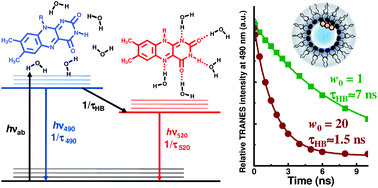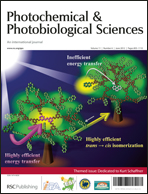The singlet and triplet excited states properties of lumiflavin (LF), riboflavin (RF), flavin mononucleotide (FMN) and flavin adenine dinucleotide (FAD) in reversed micelles (RM) of sodium docusate (AOT) in n-hexane solutions were evaluated as a function of the water to surfactant molar ratio, w0 = [H2O]/[AOT], by both steady-state and time-resolved absorption and fluorescence spectroscopy. The results indicated that hydrogen-bonding interactions between the isoalloxazine ring of the flavins with the water molecules of the micellar interior play a crucial role on the modulation of the excited state properties of the flavins. Fluorescence dynamic experiments in the RM, allowed the calculation of similar values for both the internal rotational time of the flavins (θi) and the hydrogen-bonding relaxation time (τHB), e.g. ≈ 7 and 1.5 ns at w0 = 1 and 20, respectively. In turn, the triplet state lifetimes of the flavins were also enlarged in RM solutions at low w0, without modifications of their quantum yields. A hydrogen bonding relaxation model is proposed to explain the singlet excited state properties of the flavins, while the changes of the triplet state decays of the flavins were related with the global composition and strength of the hydrogen bonding network inside of the RM.

You have access to this article
 Please wait while we load your content...
Something went wrong. Try again?
Please wait while we load your content...
Something went wrong. Try again?


 Please wait while we load your content...
Please wait while we load your content...